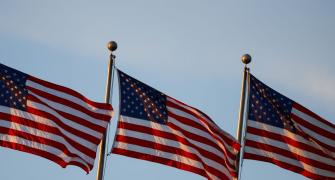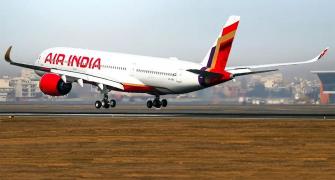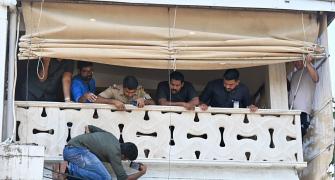Some eyebrows were raised over Dr Singh's decision to visit Brazil and then Cuba for the Non-Aligned Movement summit while skipping the United Nations General Assembly in New York.
It is believed that since Brazil is the chair of the Nuclear Suppliers Group, and it also has sizeable uranium deposits, Dr Singh wants to forge closer ties with the Latin American giant.
India has already started negotiations with the NSG seeking its endorsement of the India-US nuclear deal, which is now before the United States Congress.
Dr Singh will also participate in the first summit of India-Brazil-South Africa leaders on September 12 and 13.
Launched by the leaders of the three countries as a forum for South-South cooperation on June 2, 2003, the initiative aims at promoting multi-sectoral ties in political, economic and cultural spheres.
The three nations want to forge partnership in areas as diverse as health, agriculture, tourism, civil aviation, science and technology, infrastructure, trade and investment, education, energy, climate change and social issues.
India is trying to woo Latin America, and Brazil is an important stop.
As part of the process of stepping up economic ties, ONGC Videsh acquired a 15% stake by investing $410 million in an offshore block in south-east Brazil in April. GAIL and Petrobras signed a cooperation and confidentiality agreement on June 21. Petrobras has also shown interest in evolving a partnership with GAIL for investment in oil blocks in Iran.
In May, Tata Motors and Marcopolo announced the formation of a joint venture company in India to assemble built buses and coaches. The joint venture with a 51% Tata stake is expected to go on stream in a year's time.
Brazil is a strong advocate of UN Security Council reform and is part of the G-4 along with India, Japan and Germany.
On WTO issues, Brazil and India have been in the forefront of the G-20 in raising their voice particularly on the liberalisation of agricultural imports by developed countries and to ensure equitable international trade.
Like India, Brazil is a study in diversity. Apart from the native Indians, now mostly spread over the Amazon basin, it has a multi-racial society comprising migrants from Portugal, Spain, Italy, Germany, Lebanon, Japan, Korea, China and Africa. There is also a small Indian community.
Despite racial inter-mingling, political and economic power is monopolised by people of European origin, and the official language is Portuguese. Brazil, in fact, is the only country in South America, where Spanish is not the official language.
While most Brazilians are Roman Catholic, an African origin cult, Candomble, is still strong among its people and it co-exists with the Catholic faith. An estimated 6 million Africans had been brought to Brazil by 1810 as slaves to work in the mines and plantations.
Though it accounts for 20 per cent of the world's arable land and nearly 20 per cent of the world's fresh water resources, there is immense economic disparity among the citizens of the country, with just 10 per cent of the people owning 47 per cent of the national wealth.
While its GDP at $795 million in 2005 overtook Mexico to place it as the front ranking economy in Latin America, about 40 per cent of the population still lives below the poverty line.
Its literacy rate is impressive at 85 per cent, but organised gang rivalry and drug wars lead to around 40,000 homicides every year.
Very little is known about the history of Brazil before before Cabral's arrival in 1500 and the subsequent Portuguese colonisation. A redwood tree, called 'pau-brasil', gave the country its name.
Though gold was a leading export item in the 18th century, Brazil's main exports have been agricultural: sugar, coffee, rubber, cocoa, cotton and tobacco.
Today, it is the largest exporter of coffee, orange juice and beef. It is also among the leading global exporters of sugar, soya bean, soya oil, cotton and tobacco.
Luiz Inacio Lula da Silva took over the reins on January 1, 2003 as the first-ever Left leaning/Socialist president following a landslide victory.
Owing to a bloody and prolonged border war with neighbouring Paraguay from 1864 to 1870, the country raised a large army which emerged as a major force in the country's politics. The army seized power in 1889 and remained at the helm of affairs for a century.
Following a revolt by citizens fed up with the economic mess and army misrule, President Jose Sarney took over in 1985.
The century-old war has resulted in Brazil having the largest and best equipped defence force in the region, though its defence expenditure is less than 1.5 per cent of its GDP. Its armed forces are estimated at 300,000, of which 200,000 are in the army, 50,000 in the navy, and 50,000 in the air force.
While Brazil no longer has any major border disputes, drug traffickers make use of its huge porous borders, keeping the army busy.
President Lula who came to power in 2003 is an active leader who travels around the world and makes friends.
His government's new initiatives includes the formation of 'Friends of Venezuela' group to resolve a dispute between President Chavez and his domestic opponents.
This Latin American leader is also actively wooing Africa and has visited over 15 African countries since November 2003. His government organised the first South America-Arab Summit in Brasilia in May 2005.
As expected, the US is Brazil's largest trading partner accounting for almost 20 per cent of Brazil's total trade. Bilateral trade in 2005 was $35.13 billion.
With many Latin American countries like Argentina, Uruguay, Venezuela and now Bolivia opting for Left and Socialist governments of different shades, Lula is positioning himself as an arbiter between the US and the region.
China too has emerged as a major economic partner, with two-way trade crossing $12 billion in 2005. Lula visited China in May 2004 followed by Chinese President Hu Jintao's return visit in November the same year.
Brazil is the eighth largest producer of steel in the world with 27 million tons per year. It has the world's largest iron ore reserves, estimated at 48 billion tons, enough to meet the world demand in the next 500 years.
Brazil also has huge deposits of manganese, bauxite and nickel, besides reserves of uranium, lead, graphite, chrome and thorium.
The country also produces 90 per cent of the world's supply of gems such as diamonds, topaz, emeralds and amethysts. It is among the world's top producers of foodstuffs and has a modern and competitive textile industry.
Brazil is the third largest producer of shoes in the world, with a highly competitive leather industry; it is a top producers of soda drinks; it is the fourth largest producer of commercial aircraft in the world and its rubber industry is sturdy.
Brazilian women are very beauty-conscious, and the country is the sixth largest market for cosmetics, with US $9 billion of sales per year.
It is also one of top producers of vehicles, churning out 1.8 million vehicles per year. Where is India most visible in Brazil? In its green farmlands.
A huge bulk of Brazilian cattle livestock is of Indian origin. The 'Ongole' strain from Andhra Pradesh led to the production of the variety 'Zebu' known in Brazil as 'Nelore'. Brazil still imports fresh embryos from India to rejuvenate its cattle breed.
India-Brazil trade has grown from a modest $200 million in late 1990s to $2.5 billion in 2005. India's leading export items include diesel oil, coal and chemicals, while it imports sugar, soya bean oil, chemicals and iron ore from Brazil.
The two countries are exploring joint ventures in agriculture, joint production of aircraft, and in improving the road and rail network and of course the IT industry. Bazil can also help India secure its food and energy needs through supplies of sugar and ethanol.
Between the 16th and 18th centuries, Brazil and Goa, both colonised by the Portuguese imperialists, had major bilateral exchanges which are reflected in the flora and fauna, food and dress as well as folk traditions of Brazil. The similarities between the folk traditions of Boi Bumba in northern Brazil and the Poikam Kudharai of south India are evidence of the cultural links of a bygone era.
Dr Singh can expect a warm welcome during his stay in the capital, Brasilia.






